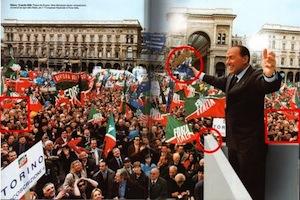Now, hands up all those readers who are guilty of editing their holiday snaps, for surely we all do it these days? Who does not “improve” their photos a little with a digital editor before pressing the “share” button? “And where’s the harm in that?” you may ask. Well, the trouble is that we are not all the Prime Minister of Italy so our photos are not going to be scrutinised by millions of people, including experts in photography and lighting.
The photos in a book about Mr Berlusconi which went on sale last week have undergone just such close examination and the verdict is that they have been rather clumsily adjusted. The book, entitled “Noi amiamo Silvio” [“We Love Silvio”] is, according to its publisher and editor, Alberto Peruzzo, a testimony to Mr Berlusconi’s commitment to his work in the national and international spheres. The Premier is pictured among flag-waving supporters and with other world leaders.
One photograph in particular drew the attention of Vacon Sartirani, a graphic designer from Bergamo, Corriere della Sera reports. Mr Sartirani bought the book out of professional curiosity, having heard much criticism of the editing and graphics.
When he turned to the image in question, of Mr Berlusconi with supporters in Milan’s Piazza del Duomo, two things immediately struck him: the first was the caption, which wrongly dates the photo to 2008 when it was actually taken in 1998 and the other was that the crowd has been “cloned”, for if you look carefully you can see exactly the same people in each half of the image.
Mr Berlusconi is holding some flowers, which, seen through a magnifying glass, are obviously drawn. Mr Sartirani scanned the photo and sent it to the San Precario blog, whose readers have been having a very jolly time finding other inconsistencies in it.
Mr Sartirani says that in other photos in the book Mr Berlusconi’s features have been lit in a totally different way from those of bystanders. Although this is normal practice with pictures of the rich and famous, here it has been badly done, he adds.
Mr Peruzzo, the editor, shrugs his shoulders in the face of all this criticism and declares himself to be merely a politically neutral friend of Mr Berlusconi. He admits that he showed a draft of the book to the Premier, who suggested some changes, before ordering the print run of 70,000 copies. Mr Peruzzo remains convinced that the book will be a success.
So, the moral of the story is: we need to be careful with those Photoshop retouches. We don’t want to end up on the Photoshop disasters site, do we?
Do you retouch your digital photos?
Do you think digital retouching is deception?









